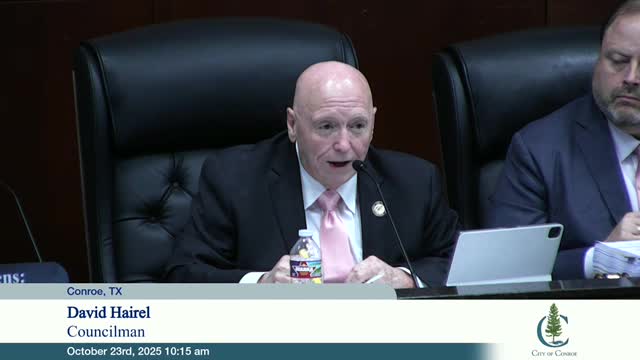Wastewater master plan warns Conroe needs up to $483M in near-term projects; Southwest plant hits 75% capacity by 2028 under growth assumptions
October 23, 2025 | Conroe, Montgomery County, Texas
This article was created by AI summarizing key points discussed. AI makes mistakes, so for full details and context, please refer to the video of the full meeting. Please report any errors so we can fix them. Report an error »

City engineers and consultant firms Fries & Nichols presented the 2025 Wastewater Master Plan to the Conroe City Council on Oct. 23, concluding that projected growth will require prioritized sewer collection and treatment improvements over the next decade and beyond.
Key findings: the city’s two treatment plants and its lift-station network will need upgrades and expansions to meet rising flows. The Southwest Regional Treatment Plant (the older facility) currently operates at a permitted 12 million gallons per day (MGD) annual average flow and 36 MGD peak; the newer Conroe Central plant is permitted at 6 MGD interim with expansions to 12 MGD included in its permit. The consultant showed that, under the city’s growth projections, wastewater flows will reach or exceed permitted capacity by 2035 and that the Southwest plant will cross 75% of permitted capacity around 2028 — a regulatory trigger that requires planning to begin.
The plan and costs
Fries & Nichols delivered a technical report and an updated hydraulic model for staff use. The consultant identified 16 projects in a five‑year capital-improvement plan (CIP), three projects in a 10‑year CIP, one renewal project and sanitary‑sewer evaluation survey (SSES) recommendations. The total planning-level cost for those projects in 2025 dollars was presented at about $483 million.
For the largest treatment alternatives, the consultant said inflation should be included for budgeting: using a 6% annual inflation assumption for major treatment projects increases the modeled cost for one expansion alternative to about $383 million (inflation-adjusted) when planning years are included.
Regulatory timing and next steps
Consultants stressed regulatory benchmarks: at 75% of permitted capacity the Texas Commission on Environmental Quality (TCEQ) guidance requires entities to begin planning an expansion; at 90% of permitted capacity they should begin construction. Because planning and construction together can take five to six years, the city was advised to start planning immediately for the Southwest plant. The firm also recommended prioritized SSES work (sewer‑system condition surveys) in three new areas to target recurring infiltration and inflow problems.
Council and staff comments
Public‑works staff and consultants said field flow monitoring and recent rehabilitation work have shown improvement since the 2018 plan, but that near-term growth will outpace legacy capacity absent investment. The report updates the wastewater hydraulic model so staff can review new development proposals against the system’s capacity.
Quotes
"At 75% of the permitted capacity is when the entity needs to start planning for an expansion, and when you get to 90%, you start construction for the expansion," a Fries & Nichols presenter told council members.
Ending
Council did not take immediate action to adopt a specific funding package during the meeting but received the report for planning purposes. Staff and consultants recommended integrating the prioritized projects into the city’s budgeting process and beginning planning steps for treatment expansion and targeted sewer rehabilitation work.
Key findings: the city’s two treatment plants and its lift-station network will need upgrades and expansions to meet rising flows. The Southwest Regional Treatment Plant (the older facility) currently operates at a permitted 12 million gallons per day (MGD) annual average flow and 36 MGD peak; the newer Conroe Central plant is permitted at 6 MGD interim with expansions to 12 MGD included in its permit. The consultant showed that, under the city’s growth projections, wastewater flows will reach or exceed permitted capacity by 2035 and that the Southwest plant will cross 75% of permitted capacity around 2028 — a regulatory trigger that requires planning to begin.
The plan and costs
Fries & Nichols delivered a technical report and an updated hydraulic model for staff use. The consultant identified 16 projects in a five‑year capital-improvement plan (CIP), three projects in a 10‑year CIP, one renewal project and sanitary‑sewer evaluation survey (SSES) recommendations. The total planning-level cost for those projects in 2025 dollars was presented at about $483 million.
For the largest treatment alternatives, the consultant said inflation should be included for budgeting: using a 6% annual inflation assumption for major treatment projects increases the modeled cost for one expansion alternative to about $383 million (inflation-adjusted) when planning years are included.
Regulatory timing and next steps
Consultants stressed regulatory benchmarks: at 75% of permitted capacity the Texas Commission on Environmental Quality (TCEQ) guidance requires entities to begin planning an expansion; at 90% of permitted capacity they should begin construction. Because planning and construction together can take five to six years, the city was advised to start planning immediately for the Southwest plant. The firm also recommended prioritized SSES work (sewer‑system condition surveys) in three new areas to target recurring infiltration and inflow problems.
Council and staff comments
Public‑works staff and consultants said field flow monitoring and recent rehabilitation work have shown improvement since the 2018 plan, but that near-term growth will outpace legacy capacity absent investment. The report updates the wastewater hydraulic model so staff can review new development proposals against the system’s capacity.
Quotes
"At 75% of the permitted capacity is when the entity needs to start planning for an expansion, and when you get to 90%, you start construction for the expansion," a Fries & Nichols presenter told council members.
Ending
Council did not take immediate action to adopt a specific funding package during the meeting but received the report for planning purposes. Staff and consultants recommended integrating the prioritized projects into the city’s budgeting process and beginning planning steps for treatment expansion and targeted sewer rehabilitation work.
View full meeting
This article is based on a recent meeting—watch the full video and explore the complete transcript for deeper insights into the discussion.
View full meeting
